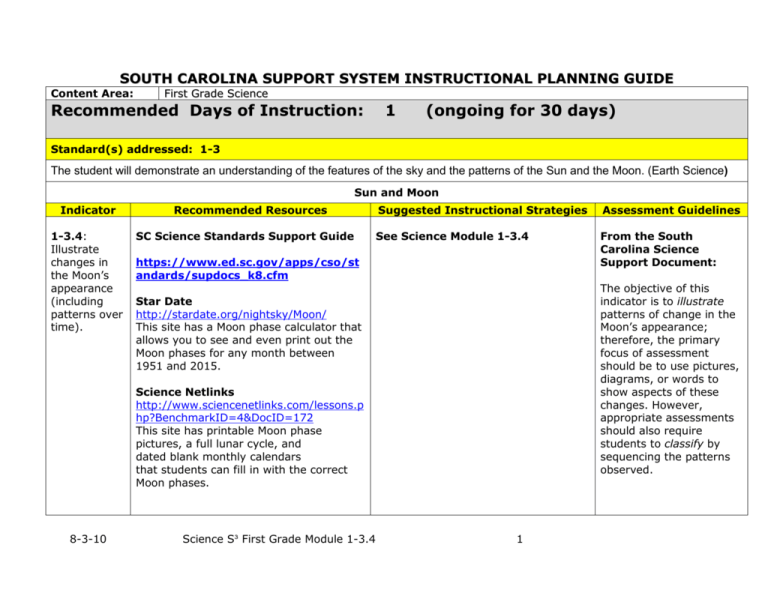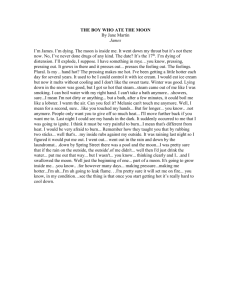1-3.4 - S2TEM Centers SC
advertisement

SOUTH CAROLINA SUPPORT SYSTEM INSTRUCTIONAL PLANNING GUIDE Content Area: First Grade Science Recommended Days of Instruction: 1 (ongoing for 30 days) Standard(s) addressed: 1-3 The student will demonstrate an understanding of the features of the sky and the patterns of the Sun and the Moon. (Earth Science) Sun and Moon Indicator 1-3.4: Illustrate changes in the Moon’s appearance (including patterns over time). Recommended Resources SC Science Standards Support Guide Suggested Instructional Strategies Assessment Guidelines See Science Module 1-3.4 From the South Carolina Science Support Document: https://www.ed.sc.gov/apps/cso/st andards/supdocs_k8.cfm The objective of this indicator is to illustrate patterns of change in the Moon’s appearance; therefore, the primary focus of assessment should be to use pictures, diagrams, or words to show aspects of these changes. However, appropriate assessments should also require students to classify by sequencing the patterns observed. Star Date http://stardate.org/nightsky/Moon/ This site has a Moon phase calculator that allows you to see and even print out the Moon phases for any month between 1951 and 2015. Science Netlinks http://www.sciencenetlinks.com/lessons.p hp?BenchmarkID=4&DocID=172 This site has printable Moon phase pictures, a full lunar cycle, and dated blank monthly calendars that students can fill in with the correct Moon phases. 8-3-10 Science S³ First Grade Module 1-3.4 1 U.S. Naval Observatory http://aa.usno.navy.mil/data/ This site is an online almanac for the rising and setting of the Moon and Sun for any date -past, present or future. You can check your own observations of the Moon and Sun against the almanac. Note: Some information is too advanced for students; appropriate for teacher background information. http://aa.usno.navy.mil/faq/docs/Moon_p hases.html Phases of the Moon and Percent of the Moon Illuminated http://tycho.usno.navy.mil/vphase.html Virtual Reality Moon Phase Pictures Literature Links: Harold's Trip to the Sky by Crockett Johnson Goodnight Moon by Margaret Wise Brown Mooncake, MoonGame and Happy Birthday Moon by Frank Ashe Earth and Moon, Exploring Space, and Sun Up Sun Down by Gail Gibbons, There's No Place Like Space (with the Cat in the Hat) by Tish Rabe Me and my Place In Space and Blast Off! by Maryann Dobeck. Papa Please Get the Moon for Me by Eric Carle. I Want to be an Astronaut by Byron Barton. 8-3-10 Science S³ First Grade Module 1-3.4 2 First Grade Science Module 1-3.4 Sun and Moon Standard 1-3: The student will demonstrate an understanding of the features of the sky and the patterns of the Sun and the Moon. (Earth Science) Indicator 1-3.4: Illustrate changes in the Moon’s appearance (including patterns over time). Other indicators addressed: 1-1.1: Compare, classify, and sequence objects by number, shape, texture, size, color, and motion, using standard English units of measurement where appropriate. 1-1.3: Carry out simple investigations when given clear directions. 1-1.4: Use appropriate safety procedures when conducting investigations. 8-3-10 Science S³ First Grade Module 1-3.4 3 From the South Carolina Science Support Documents: Indicator 1.3.4: Illustrate changes in the Moon’s appearance (including patterns over time). Taxonomy level: Understand Conceptual Knowledge (2.2-B) Previous/Future knowledge: This is the first time that students have been introduced to the concept of the Moon’s changes. Students have investigated patterns in kindergarten. This is foundational knowledge that will be further developed in 4th grade (4-3.6) when students illustrate the phases of the Moon and the Moon’s effect on ocean tides. In 8th grade (8-4.4), students will explain the motions of Earth and the Moon and the effects of these motions as they orbit the Sun (including day, year, phases of the Moon, eclipses, and tides). It is essential for students to know that the Moon’s appearance changes over time. The Moon is a ball of rock that moves around Earth. The Moon goes around Earth about once every month. The Moon does not make its own light. We see the Moon because the Sun’s light shines on it. As the Moon moves around Earth, it appears to change shape. For example, we can see the entire Moon, part of the Moon, or none of the Moon. The appearance of the Moon changes shape in a regular pattern each month. It is not essential for students to collect data on other objects in the night sky, such as planets, or name the phases of the Moon. Assessment Guidelines: The objective of this indicator is to illustrate patterns of change in the Moon’s appearance; therefore, the primary focus of assessment should be to use pictures, diagrams, or words to show aspects of these changes. However, appropriate assessments should also require students to classify by sequencing the patterns observed. 8-3-10 Science S³ First Grade Module 1-3.4 4 Teaching Indicator 1-3.4: Lesson A: “Moon Calendar” Instructional Considerations: In this lesson students will make a Moon chart to record data for the month. During calendar activities each day, track the phases of the Moon from student observations the previous evening, from the local newspaper, or from websites. In order to completely address this indicator, students should also discuss what the Moon is like as far as its physical properties are concerned. There are commercial models of the Moon, Sun and Earth available or you can make one using a flashlight for the Sun, a Styrofoam ball for the Moon and a basketball for the earth. With the classroom lights off, students can easily see that the Moon shines because of reflected light from the Sun. They can also easily observe that the Moon’s shapes are caused by the shadow of the Earth on the surface of the Moon. As humans first did when studying the Moon, this lesson has students: Observing the Moon. Watching for patterns in change. Making predictions about what will happen based on collected data. Thinking about how and why the patterns are made Note: Do not limit observations to nighttime occurrences! Often the Moon will not be visible before the bedtime of students at this young age. As you introduce the observations that they will do during this time, ask them to watch for the Moon in the sky while waiting for the bus, at recess, when they get home, etc. Preparation for the Lesson: Provide a calendar of Moon rise and set times for the parents and a full explanatory letter about the activity. Misconceptions: Children at this developmental stage hold many misconceptions about the Moon. These misconceptions include: The Moon makes light the same way the Sun does. The Moon can only be seen at night. The Moon makes its own light, instead of reflecting Sunlight. The changes in the appearance of the Moon’s shape are caused by clouds. The Moon orbits the Sun instead of the Earth. Because of the misconceptions that can be created, it is vital that instruction at this early level does not go beyond the requirements of the SC Science Academic Standards. Safety Note(s): None noted for this lesson. Lesson time: 1 day (45 minutes) and ongoing for 30 days 8-3-10 Science S³ First Grade Module 1-3.4 5 Note: After the introductory lesson, this module requires students to make observations and discuss those observations in class for a full month. Materials Needed: Two student calendars (per student) One class calendar (Poster size) Markers KWL chart (What we think we know, what we want to know, what we learned) created by the teacher Goodnight Moon, by Margaret Wise Brown Student science notebooks Pencils Focus Question: How does the Moon appear to change shape over time? Engage: 1. Begin the class by reading the story, Goodnight Moon. 2. Review and discuss the things seen in the night sky. Tell students that they will be observing the Moon. 3. On a KWL chart, write responses from the students of what they know about the Moon and what they want to know or find out about the Moon. The last column, the learned part, will be filled in after the lessons are completed. Explore: 1. Ask the students to illustrate in their science notebooks some of the various “shapes” of the Moon that they have observed in the past. 2. Bring the students together and let them share their illustrations. 3. Explain to them that they will be observing the Moon for a month to see if there are patterns to the changes in the Moon’s appearance. Explain: 1. Show the class the student calendar and describe how they will record their observations. 2. Give each student two student calendars. Explain the one calendar will be used for observing at home each night for the next thirty days and the other one will be kept in their science notebooks. 3. Point out the class calendar and explain to the children that each day they will also record the Moon’s shape on this calendar. Extend: 1. Each day have the students share their observations from the previous night. This can easily be done during calendar time. 2. Record the Moon’s shape on the class calendar. This can be done by the teacher or one of the students. (On Mondays, record the shapes from both Saturday and Sunday.) 3. Lead a brief discussion about the changes they are seeing and if any patterns are emerging. 8-3-10 Science S³ First Grade Module 1-3.4 6 4. Have the students record the shape of the Moon on the calendar in their science notebooks. (Maintaining this additional record will ensure that the children have a representation of their observations if their home calendar is misplaced.) 5. After thirty days of observations, discuss with the children the patterns that they noted as the Moon changed in appearance. 6. Explain to the children that the Moon moves around the Earth. It takes 24 days for the Moon to move all the way around the Earth. As the Moon moves in the sky, it appears to change shape and there is a pattern to that change. Note: Do not go beyond the recommendations in the Standards Support Guide in the explanation provided to these young children. 8-3-10 Science S³ First Grade Module 1-3.4 7







